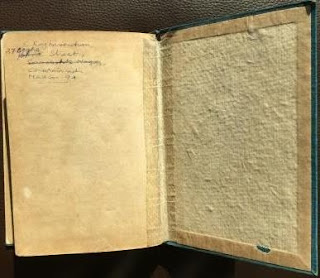In this example, we are working on restoring a fairly recent book published in 1972, but the quality of the paper and binding is quite poor.
Let us take a look:
Observations
This is the first edition of the book, 'Voice Real' published by SRCM in India in 1972.

This book looks pretty nice on the outside. But let us turn the page.
We notice that:
- The quality of the paper is quite poor. It is acidic, and is turning the paper to yellow
- Paper appears brittle
- Stopgap repairs have been undertaken, by gluing a piece of paper to keep the book block attached to the spine
We can see that the paper is so brittle that it is breaking apart.
The book has some photographs printed on art paper (Ceramic coated paper), and a tape has been used to keep it together
The color of the paper is turning yellow, which indicates that the paper is acidic. Acidic papers age very quickly and turns the paper brittle.
The book is a tightback
Hot glue has been used to glue the spine to the cloth cover
The binding has come apart, and is in poor condition.
Another view of how brittle the spine is.
Some pages appear to be a lot further into the process of aging. We can see this from the difference in the color of the paper.
Also, we can see that some of the pages (beginnings of chapters, etc.), do not have page numbers. It is important that all pages are numbered before we proceed.
The book block is coming apart in the spine, all across the book. The issue is not only with the binding, but the book block as well. It is in poor shape indeed.
Several pages have been underlined with pens and pencil. We are not sure at this stage if this has been done with an ink pen or with a ball pen.
A soft ear bud (QTip) can be moistened with water and swabbed on the paper where the ink is present to see if the ink runs off. If it does, it indicates further processing is required to fix the ink on paper. If it does not, we can proceed with the next steps.
This has to be done for every ink mark in the book. We cannot assume that the same pen would have been used to make all the ink marks.
Pencil marks are not a problem, and do not pose any issues when processing the folios.
In this case, we are still in the process of learning, and will proceed without further processing.
Tapes used on the end paper towards the end of the book as well.
In normal circumstances, annotations such as this are considered valuable and should be preserved,
The book is coming apart at several points in the spine. The paper has turned brittle and the hot glue used has lost all its adhesion properties.
Some pages / sections are intact, and the sewing is still in position.
There are multiple photographs that have been printed in art papers, and have been tipped onto the book block.
Preparatory Steps for Restoration
Preparatory steps before beginning to work on the project include:
- Numbering all pages, with a pencil
- Identifying any missing pages / Folios
- Determining how many pages / folios make up each section
- Assessing the type of binding (Hollow / Tightback), Type of sewing, end bands (Present or absent), Type of material used for binding (Paper, Calico), Type of glue, presence and numbers of photographic plates, etc.
- If photographs are present, note down the position where they are inserted
Determine the nature of repair to be carried out. In all cases, the choice is always one of the degree of effort, which directly implies the balance between time / cost on on hand, and the extent of restoration. The basis for this determination is always the value of the book, and how much effort needs to be invested to restore the book.
Having made the assessment, we will proceed to disassemble the book and begin the restoration process. Continue the journey by clicking here...












I like the way you made it so visual. It sounds really simple but there is so much 'savoir faire' behind this. It is all the more valuable today as our books are floating in the remaining muddy water of Chennai. Thanks for posting. Share more. DN
ReplyDeleteThanks, Dolly! Hoping to get this moving... At least, that's the plan
Deletevery detailed tutorial!! Lot to learn for all of us for Shri Ram Chandra Mission.
ReplyDelete